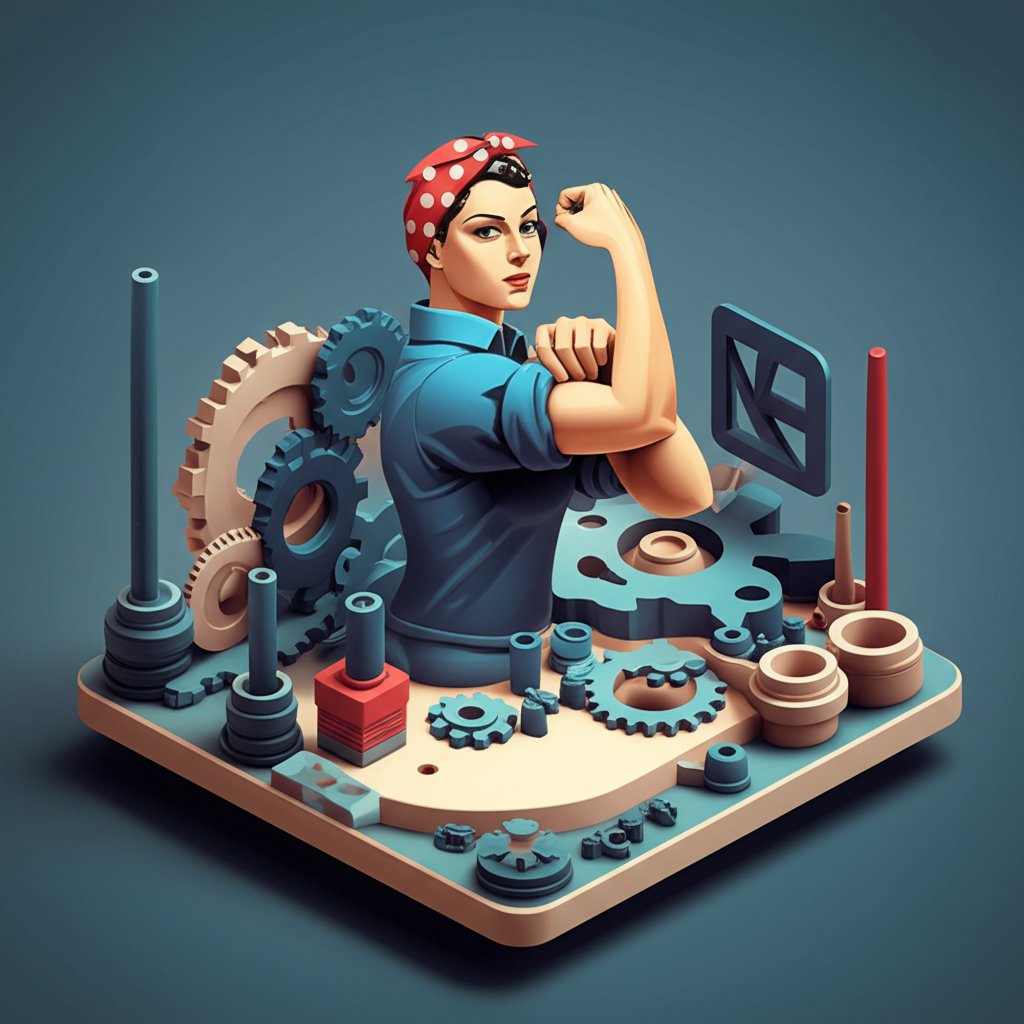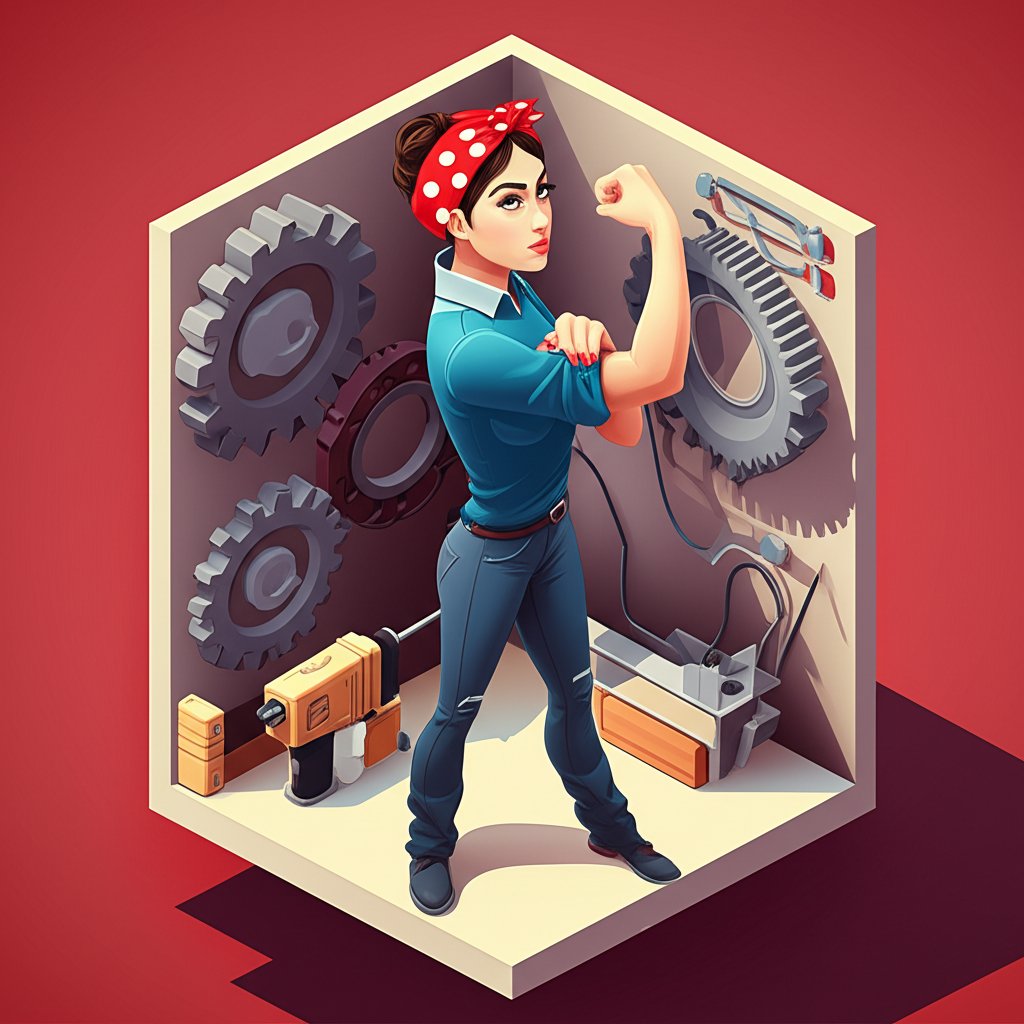Picture this: a determined woman with sleeves rolled high, a vibrant red bandana keeping her hair back, and a gaze that radiates unwavering strength. This isn’t just a nostalgic image; it’s Rosie the Riveter, the enduring symbol of female empowerment WWII and an American icon whose iconic look Rosie the Riveter continues to inspire. More than a simple disguise, donning a Rosie the Riveter costume is a powerful statement, a tribute to millions of women who shattered gender norms and fueled the war effort from the home front.
This comprehensive guide will not only help you perfectly assemble your own powerful Rosie the Riveter dress or workwear ensemble but will also delve into her fascinating history, the symbolism behind her look, and her lasting legacy in an ever-changing world. Get ready to master a look that speaks volumes about resilience, determination, and the indomitable spirit of women.
The Enduring Legacy of Rosie the Riveter

Before we dive into the threads and pins, understanding the deep roots of Rosie the Riveter is crucial to truly embodying her spirit. She represents a pivotal moment when women stepped into roles traditionally reserved for men, proving their capabilities far beyond societal expectations.
Who Was Rosie, and Why Does She Matter?
Rosie the Riveter wasn’t a single individual but a composite figure, a powerful archetype representing the millions of American women who entered the workforce during World War II. They toiled in factories, shipyards, and munitions plants, filling the void left by men deploying overseas. These “Rosies” built planes, ships, and weapons, demonstrating immense strength, skill, and patriotism. Their collective efforts were indispensable to the Allied victory and fundamentally reshaped conversations around women’s roles in society. This era became a defining moment for female empowerment WWII, forever changing the trajectory of women’s rights and opportunities.
The Birth of an Icon: From Propaganda to Pop Culture
The image of Rosie the Riveter solidified through various artistic representations. The most famous is J. Howard Miller’s “We Can Do It!” poster, created for Westinghouse Electric and featuring a strong woman flexing her bicep. While not initially widely known, this poster became synonymous with Rosie many decades later. Earlier, more widely recognized depictions included Norman Rockwell’s “Rosie the Riveter” painting for the Saturday Evening Post in 1943, which showcased a brawny woman with a rivet gun, lunch pail, and a copy of Mein Kampf under her foot.
These images, born out of wartime propaganda, quickly transcended their original purpose. They became potent symbols of female strength, self-reliance, and national unity. The iconic look Rosie the Riveter portrayed became ingrained in the public consciousness, a visual shorthand for a generation of powerful women.
Deconstructing the Authentic Rosie the Riveter Costume
Understanding Rosie’s impact requires us to look back at how clothing and roles for women have evolved, which is a fascinating area explored within the broader context of the history of dressmaking.
The authenticity of a Rosie the Riveter costume lies in its practicality and symbolic elements. Each piece tells a part of her story, from protecting workers to proclaiming a collective spirit. Understanding these components is key to accurately recreating her powerful image.
The Foundation: Practical Workwear
At its core, Rosie’s attire was functional workwear. Women worked long, arduous shifts, often in hazardous conditions, so their clothing needed to be durable, comfortable, and safe.
- Denim Overalls or Jumpsuits: These were common for factory workers, offering full-body protection and ease of movement. For an authentic Rosie the Riveter costume, a denim jumpsuit or sturdy utility overalls are excellent choices. They embody the hands-on, no-nonsense attitude of the era.
- Chambray or Denim Shirt: Paired with trousers or worn under overalls, a long-sleeved chambray or denim shirt was a staple. Rolled-up sleeves are crucial, signifying readiness for hard work and revealing the iconic flexed bicep.
- Sturdy Trousers: High-waisted, wide-leg trousers in denim or other durable work fabrics were also common. These offered more flexibility than skirts and were safer around machinery.
- The “Rosie the Riveter Dress” Adaptation: While not historically a “dress” in the conventional sense, modern interpretations often feature a denim or utility-style dress that captures the spirit of the workwear but offers a more contemporary silhouette. This can be an excellent option for a comfortable yet recognizable Rosie the Riveter dress look.
The Signature Red Bandana: Style & Safety
Perhaps the most recognizable element of the iconic look Rosie the Riveter is her red polka-dot bandana. This wasn’t just a fashion accessory; it served a vital safety purpose, keeping hair neatly tucked away from dangerous machinery. Over time, its bright red color and prominent placement transformed it into an unintentional symbol of defiance, patriotism, and unity among working women. For your Rosie the Riveter costume, this piece is non-negotiable.
The “We Can Do It!” Button: A Symbol of Determination
The “We Can Do It!” poster’s message became the unofficial motto of the women on the home front. A pin featuring this slogan, often accompanied by Rosie’s flexing arm, is a powerful addition to any Rosie the Riveter costume. It encapsulates the era’s can-do spirit and the collective strength of women.
Beyond the Basics: Hair, Makeup & Footwear
- Hair: Practicality was paramount. Hair was typically pulled back and often covered by the bandana. Simple, functional styles prevented snags in machinery.
- Makeup: Minimal to no makeup was the norm. The focus was on work, not elaborate beauty routines. A clean, determined face is part of the authentic look.
- Footwear: Sturdy, practical work boots or ankle boots were essential for protection and comfort during long shifts on factory floors. Avoid high heels or delicate shoes for a truly authentic Rosie the Riveter costume.
Craft Your Own Iconic Rosie the Riveter Look (Step-by-Step Guide)
Recreating the Rosie the Riveter costume is straightforward and can be adapted to various budgets and preferences, whether you’re aiming for historical accuracy or a stylish modern nod.
Step 1: Choose Your Base
Decide on the foundation of your Rosie the Riveter look:
- Classic Workwear (Most Authentic): Opt for a denim or chambray button-up shirt (sleeves rolled!) paired with sturdy, high-waisted denim or utility trousers, or go for a full denim jumpsuit or overalls.
- The “Rosie the Riveter Dress” (Modern Twist): Select a denim A-line dress, a utility-style shirt dress, or a sturdy colored cotton dress. Ensure it has an industrial or practical feel, not overtly fashionable.
Step 2: The Essential Accessories
These are the non-negotiables for her iconic look Rosie the Riveter:
- Red Polka-Dot Bandana: Tie it securely around your head, with the knot at the top or side, allowing some hair to peek out, curled or styled.
- “We Can Do It!” Pin: Affix this pin prominently to your shirt collar, pocket, or jumpsuit bib. You can purchase these readily online or even make your own (see DIY tip below).
Step 3: Hair, Makeup & Attitude
- Hair: Pull hair back into a bun or ponytail. If your hair is short, ensure it’s neatly styled to stay out of your face.
- Makeup: Keep it minimal. A touch of mascara and a natural lip color are fine, but the focus should be on a clean, determined expression.
- Footwear: Lace-up work boots or sturdy, low-heeled practical shoes complete the ensemble.
- Attitude: Stand tall, flex that bicep, and embody the confidence and resilience of the women who inspired Rosie!
DIY vs. Buy: Your Options for a Perfect Costume
- DIY Enthusiast: Many elements can be sourced from your existing wardrobe or thrift stores. A plain red bandana can be polka-dotted with fabric paint. A “We Can Do It!” pin can be crafted from cardboard, paper, and a safety pin.
- Budget-Conscious Shopper: Look for affordable denim shirts, trousers, or simple utility dresses. Accessories are typically inexpensive and widely available online.
- Ready-Made Costume Seeker: Numerous online retailers and costume shops offer complete Rosie the Riveter costume kits, often including the shirt, bandana, and pin. These are convenient for a quick, impactful look.
Modern Interpretations: The Rosie the Riveter Dress and Beyond
The influence of Rosie the Riveter extends far beyond historical reenactments and Halloween parties. Her image has evolved, adapting to contemporary fashion and symbolizing enduring messages of strength and progress.
Evolving the Rosie the Riveter Dress: Contemporary Styles
While the original Rosie wore workwear, modern fashion has embraced the spirit of the Rosie the Riveter dress. Designers and individuals create contemporary versions that blend historical cues with current trends:
- Denim Shirt Dresses: These are a versatile and popular choice, offering the feel of Rosie’s work shirt in a comfortable dress silhouette.
- Utility Jumpsuits: Sleek, tailored jumpsuits in denim, khaki, or other sturdy fabrics provide a chic, modern take on Rosie’s practical attire.
- Structured A-Line Dresses: Dresses with clean lines, button fronts, and a utilitarian aesthetic can evoke Rosie’s practicality while remaining stylish.
- Fabric Choices: Beyond traditional denim, modern interpretations might use chambray, heavy cotton twill, or even linen blends for a lighter, seasonal Rosie the Riveter dress.
These modern adaptations allow women to embody Rosie’s power in various settings, from casual wear to themed events, affirming that her message is always in style.
Everyday Empowerment: Integrating Rosie’s Spirit
You don’t need a full Rosie the Riveter costume to channel her spirit. Elements of her iconic look Rosie the Riveter can be subtly integrated into everyday fashion as a personal statement of empowerment:
- The Red Bandana: Wear it as a headband, tied around your neck, or even looped on a handbag for a pop of determined color.
- Denim Jackets: A classic denim jacket, especially with rolled sleeves, pays homage to her workwear.
- Rosie-Inspired Graphics: T-shirts or accessories featuring the “We Can Do It!” slogan or Rosie’s image are popular ways to showcase her influence.
- Utility-Chic: Incorporate practical, durable clothing items like cargo pants, work boots, or robust button-down shirts into your wardrobe.
These subtle nods allow individuals to carry Rosie’s message of resilience and strength into their daily lives.
Rosie in Popular Culture: A Timeless Message
From political protests to advertising campaigns, Rosie’s image continues to be a powerful visual tool. Celebrities and activists often pose in her signature stance, adopting the iconic look Rosie the Riveter to demonstrate solidarity, advocate for women’s rights, or simply celebrate female strength. Her enduring presence in popular culture underscores the timelessness of her message and her continued relevance as a symbol of progress and determination.
Beyond the Bicep: Controversies and Deeper Meanings of Female Empowerment WWII
While Rosie the Riveter is celebrated, her narrative is not without complexities and controversies that warrant deeper understanding. A truly authoritative look at Rosie must acknowledge these nuances.
The Whitewashing of History: Overlooked Contributions
One significant critique of Rosie’s image is the historical whitewashing that often accompanied it. The iconic posters predominantly featured white women, inadvertently sidelining the immense contributions of women of color, particularly African American, Latina, and Indigenous women, who also worked tirelessly in factories and other essential roles during WWII. These women often faced double discrimination, enduring both racial and gender bias, yet their dedication to the war effort was unwavering. It’s crucial to remember that female empowerment WWII was a diverse movement, and Rosie’s symbol should be broadened to encompass all who contributed.
Post-War Realities: A Complex Legacy
The story of the “Rosies” didn’t end with victory. After the war, societal pressures and government policies often pushed women out of their industrial jobs and back into domestic roles, making way for returning servicemen. This demonstrated that while the war had opened doors for female empowerment WWII, the progress was not always linear or permanent. Many women, having tasted economic independence and meaningful work, resisted this return to traditional roles, fueling later feminist movements. This post-war reality adds a layer of complexity to Rosie’s legacy, reminding us of the ongoing struggle for gender equality.
Rosie’s Continued Relevance: A Call to Action
Despite these historical complexities, Rosie’s core message of strength, capability, and breaking barriers remains profoundly relevant. She inspires women globally to pursue careers, advocate for equal rights, and challenge outdated norms. Her image serves as a powerful reminder that “We Can Do It!” is not just a slogan from the past, but a rallying cry for continuous progress and inclusive empowerment.
Conclusion
Rosie the Riveter stands as an unparalleled symbol of female empowerment WWII, her iconic look Rosie the Riveter transcending time and cultural shifts. Whether you’re assembling a detailed Rosie the Riveter costume for a historical event, opting for a modern Rosie the Riveter dress for a themed party, or simply integrating her spirit into your daily style, you’re embracing a legacy of strength, resilience, and unwavering determination.
Her story reminds us of the power of collective action, the importance of challenging expectations, and the many facets of women’s contributions throughout history. So, roll up your sleeves, tie on that bandana, and let your inner Rosie shine. Remember, her message isn’t just a historical footnote; it’s a timeless call to action for every woman to declare, “We Can Do It!”
Frequently Asked Questions (FAQ) About the Rosie the Riveter Costume

What is the official Rosie the Riveter dress?
Historically, there was no single “official” Rosie the Riveter dress. Women wore practical workwear like overalls, denim jumpsuits, or sturdy shirts and trousers to their factory jobs. Modern interpretations, however, often refer to a denim or utility-style dress as a “Rosie the Riveter dress” to capture the spirit of her workwear in a contemporary, feminine silhouette.
What are the core elements of a Rosie the Riveter costume?
The core traditional elements of a Rosie the Riveter costume include:
Essential accessories like work boots and minimal makeup also contribute to the iconic look Rosie the Riveter.
How can I make a DIY Rosie the Riveter pin?
You can easily make a DIY “We Can Do It!” pin for your Rosie the Riveter costume. You’ll need:
Cut a circle from cardboard. Cover it with red paper or fabric. Draw the “We Can Do It!” slogan in white, with the blue border as seen in the original poster. Draw a simple outline of Rosie’s arm flexing. Attach a safety pin to the back, and you’re ready!
Was Rosie the Riveter a real person?
While there were real women who directly inspired different depictions of Rosie, Rosie the Riveter was primarily a symbolic figure, a collective representation of the millions of women who worked in factories and shipyards during World War II. She embodied their collective strength, determination, and patriotic contributions.
Why is Rosie the Riveter a symbol of female empowerment WWII?
Rosie the Riveter became a powerful symbol of female empowerment WWII because she represented women breaking traditional gender roles and successfully entering heavy industry and other jobs previously dominated by men. Her image showcased women’s strength, capability, and vital contributions to the war effort, proving they “Can Do It!” She inspired a generation and laid groundwork for future advancements in women’s rights.
How is the iconic look Rosie the Riveter relevant today?
The iconic look Rosie the Riveter remains relevant today as a timeless symbol of female strength, independence, and determination. It’s often used in advocacy for women’s rights, political movements, and as an emblem of resilience against challenges. Whether as a costume or a subtle fashion statement, it continues to inspire individuals to overcome obstacles and pursue their goals.
What color shirt did Rosie wear?
The most famous “We Can Do It!” poster depicts Rosie wearing a blue work shirt, often interpreted as chambray or denim. The Norman Rockwell painting of Rosie the Riveter showed her in a similar blue work shirt, making blue a historically accurate and common choice for a Rosie the Riveter costume.










